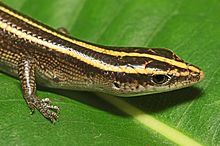Emoia impar: Difference between revisions
ShortDescBot (talk | contribs) ShortDescBot adding short description "Species of lizard" |
No edit summary |
||
| Line 13: | Line 13: | ||
}} |
}} |
||
'''''Emoia impar''''', also known as the '''dark-bellied copper-striped skink''', or the '''azure-tailed skink''' is a species of [[skink]] that is widespread in the [[Pacific Ocean|Pacific]], especially [[Polynesia]] and [[Micronesia |
'''''Emoia impar''''', also known as the '''dark-bellied copper-striped skink''', or the '''azure-tailed skink''' is a species of [[skink]] that is widespread in the [[Pacific Ocean|Pacific]], especially [[Polynesia]] and [[Micronesia]].<ref name=IUCN/> |
||
While common throughout its range, it is threatened by habitat loss, [[invasive species]], and [[sea level rise]] due to [[global warming]].<ref name="IUCN" /> It is also a [[Naturalisation (biology)|naturalized species]] in the [[Hawaiian Islands]], most likely introduced by the Polynesians, but has been almost entirely extirpated from there, possibly as a result of the invasive [[Pheidole megacephala|big-headed ant]]. It disappeared from most islands by the early 20th century, persisting on the [[Na Pali Coast]] of [[Kaua'i]] until the 1960s. Alleged sightings on Kaua'i up to the 1990s were found to have been an introduced population of ''[[Emoia cyanura|E. cyanura]]'' that was introduced in the 1970s and persisted for up to 2 decades.<ref name=":0">{{Cite journal|last=Fisher|first=Robert|last2=Ineich|first2=Ivan|date=2012/04|title=Cryptic extinction of a common Pacific lizard Emoia impar (Squamata, Scincidae) from the Hawaiian Islands|url=https://www.cambridge.org/core/journals/oryx/article/cryptic-extinction-of-a-common-pacific-lizard-emoia-impar-squamata-scincidae-from-the-hawaiian-islands/CB0269FD112EC471EA001DDB0A391545|journal=Oryx|language=en|volume=46|issue=2|pages=187–195|doi=10.1017/S0030605310001778|issn=1365-3008}}</ref> While some studies have claimed that it has been entirely extirpated from Hawaii, it actually still persists on the offshore islet of [[Kalaupapa, Hawaii|Mōkapu]], [[Molokai]], where it has a stable population.<ref name=":1">{{Cite journal|last=Wood|first=Kenneth R.|last2=Burney|first2=David A.|last3=Allison|first3=Allen|last4=Fisher|first4=Robert|date=2013/07|title=Emoia impar (Squamata, Scincidae): not extinct in the Hawaiian Islands|url=https://www.cambridge.org/core/journals/oryx/article/emoia-impar-squamata-scincidae-not-extinct-in-the-hawaiian-islands/619D74BED8FDA7FCB5B915AD3517D791|journal=Oryx|language=en|volume=47|issue=3|pages=328–328|doi=10.1017/S0030605313000616|issn=0030-6053}}</ref> Although some sources claim ''E. impar'' to be a native species to Hawaii based on the presence of a single fossil bone<ref name=":0" /><ref>{{Cite news|last=Platt|first=John R.|title=Blue-Tailed Skink Declared Extinct in Hawaii|newspaper=Scientific American Blog Network|url=https://blogs.scientificamerican.com/extinction-countdown/blue-tailed-skink-declared-extinct-in-hawaii/|access-date=2016-10-08}}</ref>, analysis of the sediments the bone was found in indicates it to have a comparatively recent origin.<ref name=":1" /> |
|||
== References == |
== References == |
||
Revision as of 04:31, 26 April 2021
| Emoia impar | |
|---|---|

| |
| In Samoa | |
| Scientific classification | |
| Domain: | Eukaryota |
| Kingdom: | Animalia |
| Phylum: | Chordata |
| Class: | Reptilia |
| Order: | Squamata |
| Family: | Scincidae |
| Genus: | Emoia |
| Species: | E. impar
|
| Binomial name | |
| Emoia impar (Werner, 1898)
| |
| Synonyms | |
|
Lygosoma impar Werner, 1898 | |
Emoia impar, also known as the dark-bellied copper-striped skink, or the azure-tailed skink is a species of skink that is widespread in the Pacific, especially Polynesia and Micronesia.[1]
While common throughout its range, it is threatened by habitat loss, invasive species, and sea level rise due to global warming.[1] It is also a naturalized species in the Hawaiian Islands, most likely introduced by the Polynesians, but has been almost entirely extirpated from there, possibly as a result of the invasive big-headed ant. It disappeared from most islands by the early 20th century, persisting on the Na Pali Coast of Kaua'i until the 1960s. Alleged sightings on Kaua'i up to the 1990s were found to have been an introduced population of E. cyanura that was introduced in the 1970s and persisted for up to 2 decades.[2] While some studies have claimed that it has been entirely extirpated from Hawaii, it actually still persists on the offshore islet of Mōkapu, Molokai, where it has a stable population.[3] Although some sources claim E. impar to be a native species to Hawaii based on the presence of a single fossil bone[2][4], analysis of the sediments the bone was found in indicates it to have a comparatively recent origin.[3]
References
- ^ a b c Hamilton, A.; Allison, A.; McCoy, M. (2012). "Emoia impar". IUCN Red List of Threatened Species. 2012: e.T196605A2465325. doi:10.2305/IUCN.UK.2012.RLTS.T196605A2465325.en.
- ^ a b Fisher, Robert; Ineich, Ivan (2012/04). "Cryptic extinction of a common Pacific lizard Emoia impar (Squamata, Scincidae) from the Hawaiian Islands". Oryx. 46 (2): 187–195. doi:10.1017/S0030605310001778. ISSN 1365-3008.
{{cite journal}}: Check date values in:|date=(help) - ^ a b Wood, Kenneth R.; Burney, David A.; Allison, Allen; Fisher, Robert (2013/07). "Emoia impar (Squamata, Scincidae): not extinct in the Hawaiian Islands". Oryx. 47 (3): 328–328. doi:10.1017/S0030605313000616. ISSN 0030-6053.
{{cite journal}}: Check date values in:|date=(help) - ^ Platt, John R. "Blue-Tailed Skink Declared Extinct in Hawaii". Scientific American Blog Network. Retrieved 2016-10-08.
- IUCN Red List least concern species
- Emoia
- Reptiles described in 1898
- Taxa named by Franz Werner
- Fauna of American Samoa
- Fauna of the Cook Islands
- Fauna of the Federated States of Micronesia
- Vertebrates of Fiji
- Fauna of French Polynesia
- Reptiles of Hawaii
- Fauna of the Marshall Islands
- Reptiles of Papua New Guinea
- Fauna of Samoa
- Reptiles of the Solomon Islands
- Fauna of Tonga
- Fauna of Vanuatu
- Extinct Hawaiian animals

